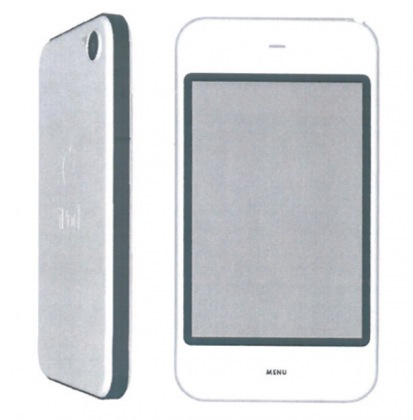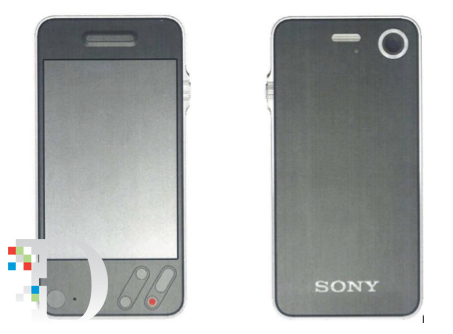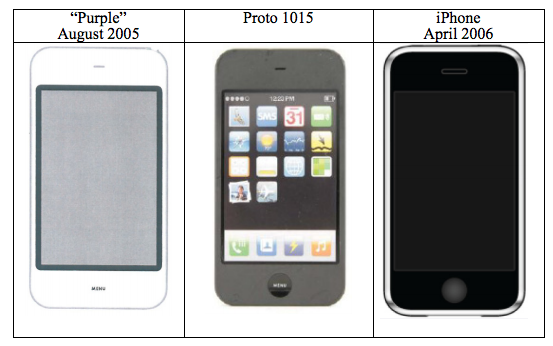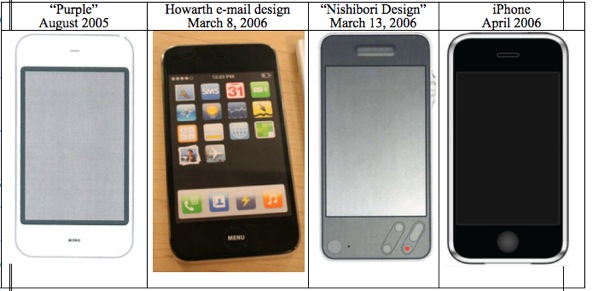Remember Apple’s Sony-infused iPhone prototype that Samsung recently showed in its pre-trial brief? The one done by designer Shin Nishibori whom Apple hired from Sony to create one of the early iPhone prototypes? As you know, Apple fought hard to keep the jury from seeing that evidence that, Samsung hopes, establishes that the Cupertino, California company lifted the iPhone’s design from Sony.
That may not have been the case as Apple offers in its brief a look at a 2005 iPhone prototype code-named Purple (nothing to do with color, it’s white actually) which the company says predates the original iPhone…
UPDATE: The Verge reports that Judge Lucy Koh has now issued an order that Samsung “will not be permitted to present evidence during the trial on the Sony-inspired designs for the iPhone”.
The Sony-inspired prototype, seen below, is credited to designer Shin Nishibori whom Apple hired from Sony to create one of the early iPhone prototypes. Samsung noted in its brief that the iPod Godfather Tony Fadell showed this Businessweek article to Apple’s late CEO Steve Jobs and design chief Jony Ive.
The story which highlights Sony’s design principles allegedly prompted Apple’s execs to approve use of some of Sony’s design principles for early iPhone mockups.
Nishibori no longer works for Apple and his lawyer wrote in a letter to the court yesterday that his client has no plans to testify in the upcoming trial.
Here’s what Apple wrote in its brief:
This design (code-named “purple”) predates by many months Mr. Fadell’s 2006 e-mail
forwarding an article about Sony design and Sony’s new Walkman. It also predates Mr. Nishibori’s March 2006 design.The existence of this design conclusively rebuts Samsung’s suggestion that Apple looked to Sony for a portable electronic device that is “square with a screen”, has “corners [which] have been rounded”, and lacks “excessive ornamentation” or buttons.
You can see all three designs compared side-by-side right below.
The company then went on to explain how the original iPhone design came to be.
Mr. Howarth, another Apple designer, testified that he and Mr. Nishibori together selected an earlier iPhone model to use as the basis to which Mr. Nishibori would add his “Sony” design details.
You can see Howart’s design right below, second from the left.
Both Apple and Nishibori say that the Sony-inspired iPhone prototype was a design exercise, a side-project if you will:
There was no conspiracy among Apple inventors to minimize Mr. Nishibori’s design exercise. Mr. Nishibori himself testified that the design exercise was to be an “enjoyable” side project and that he merely applied details, “buttons and switches,” to express the Sony style on a model phone Apple had already developed.
Then Sony CEO Howard Stringer “confirmed an understanding that it was a fun role playing type of exercise that asked ‘what would Sony do if they were us?’”, Apple’s brief reads.
Nishibori’s design exercise in no way influenced the final iPhone design, Apple alleges:
In the end, nothing came of Mr. Nishibori’s “Sony-style” detailing. First, none of its “buttons and switches” was adopted into the iPhone design.
Second, iPhone designs both before and after the Nishibori exercise embodied a symmetrical aesthetic, with centered displays and menu buttons.
In contrast, Nishibori’s design places the screen above center to make room for distinctive Sony-style diagonal buttons, and adds these asymmetrical buttons and a jog-wheel to the right side of the device.
Third, Mr. Nishibori’s “Purple” design features a protruding speaker element, as shown above and in the side view below, which is inconsistent with the flat front surface of Apple’s iPhone designs before and after Mr. Nishibori’s exercise.
The monster Apple-Samsung trial kicks off today and we have a short rundown for those interested in legal matters.



